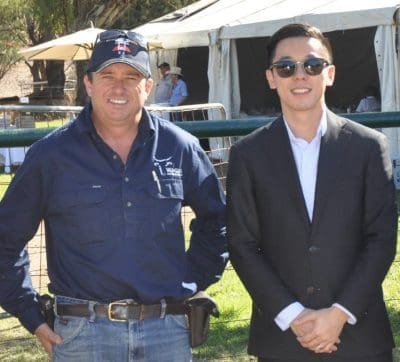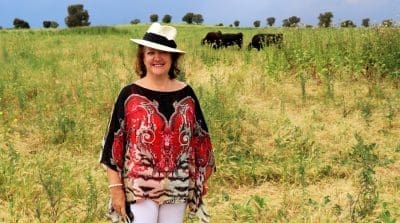PROPERTY buying activity specifically for Wagyu cattle production has been increasingly evident over the past two years, with several regions across the eastern seaboard emerging as favoured locations.
Areas like the Hunter Valley and New England region in northern NSW have become Wagyu grazing ‘conversion hot-spots’ since 2016. The trend has created its own pent-up buyer demand for suitable targets.
Peter Bishop Jr and his family have been producing stud and commercial cattle in the Hunter Valley for more than 100 years. Over the past two decades or so, they have focused heavily on Wagyu.

Peter Bishop, Wootton, with AAAW’s Michael Wang
In May last year, the Bishops sold their properties Millera and Wootton, a 3500ha Upper Hunter grazing operation and its 1100-head Kuro Kin Fullblood Wagyu herd, for about $20m to Australia Aulong Auniu Wang, the Australian subsidiary of Chinese retailing giant, Dashang Group.
The prominent Wagyu breeder suggested that while Wagyu were versatile and could handle a range of conditions, the best country for breeding Japanese Black cattle was secure country in the temperate zone, on the eastern ranges.
“The most reliable rainfall and the most suitable climate for any type of consistent cattle production stretches as far south as mid-Victoria all the way to Rockhampton in Central Queensland,” he said.
However, Mr Bishop pointed out that Wagyu had gained a strong reputation for being hardy cattle, adaptable to a range of geographic zones and climates.
“In Japan, Wagyu are bred in freezing conditions on the northern island of Hokkaido, right through to extremely humid conditions in the far south, around Kagoshima. Here in Australia, operators such as the Hughes family, the Australian Agricultural Co, Crown Cattle Co (Hughenden) and Stanbroke Pastoral run Wagyu cattle in arid, low rainfall areas of northern Australia.
“The can walk-out well, and their medium frame score means they are low maintenance when conditions get dry. They are adaptable cattle which broadens the ability to grow and produce them in a range of conditions.”
Mr Bishop said Wagyu on more marginal country were being managed by ‘smart operators.’
“Look at what Peter Hughes has been doing for the past 20 years,” he said.
Peter and Jane Hughes and family own the extensive Hughes Pastoral Co and Georgina Pastoral Co Wagyu and Certified Organic beef production streams, networked across the NT Barkly region, and northwest, northern and central Queensland.
In August last year they added 69,000ha Central Queensland showcase, Tumbar, in one of the largest property transactions of the year, worth $67.5 million. Wagyu genetics are being injected into the Angus base herd.
“Some traditional producers perceive marginal country as being run at borderline levels, but I believe with good management and innovative techniques to manage feral animals, stock water and pastures, anything is possible with Wagyu,” Mr Bishop said.
He said the numbers are starting to stack-up in terms of gross margins for beef production.
“Land prices might be rising, but premiums continue to be paid for F1 Wagyu. So, a producer doing gross margins on a beef enterprise on a temperate zone property can still get a pretty decent return per hectare, and there’s the ability to do it on irrigation as well.”
He said a cattle buyer for a large Queensland Wagyu supply chain recently told him there were three regions he liked to buy feeder Wagyu cattle from:
- Hunter Valley, NSW
- New England, NSW
- Shepparton region, VIC
Mr Bishop said all three were located in temperate zones, and had growing Wagyu populations.
“There is more reliable winter rainfall the further south you go. Here in the Hunter, there is a similar level of rainfall, but it’s all summer and it’s not as reliable. It’s more hit and miss.”
“Another good area is NSW’s Central Tablelands around Orange, Cudal, Cumnock, Cowra, Boorowa and Canowindra. Those areas receive good reliable rainfall – it always happens on time, you could bank on it. That’s why you see some of these higher-end Wagyu production systems setting up,” he said.
Gina leads the charge in Wagyu land investment

Gina Rinehart is expanding her Wagyu breeding interests, and launches a Wagyu beef brand into Asia.
Australian mining magnate Gina Rinehart entered the Wagyu industry just three years ago, purchasing several properties in the warm temperate zone around Dubbo, between the Central Tablelands and the Central Western Plains.
Since then she has made a string of land purchases and today boasts the largest Fullblood Wagyu herd in Australia:
- In November 2014, Hancock Prospecting started acquiring and aggregating a series of smaller dairy, beef and peanut properties covering more than 35,000ha in the fertile South Burnett region of southern Queensland. When original plans for the Hope Dairies Mary Valley milk powder manufacturing operation were shelved due to economic factors, her South Burnett Aggregation was re-purposed into a Wagyu beef breeding operation under the 2GR brand. Today it’s understood the operation runs at least 2000 breeders, mostly producing F1 Wagyu calves, and growing-out Wagyu feeders from other company properties.
- December 2014 – Pastoral Properties (NSW), a company associated with Hancock Prospecting, purchased the 4600ha Dubbo district grazing properties Boogadah and Caigan near Mendooran for $25m. The sale included the highly regarded Green Hills Fullblood Wagyu cattle herd, numbering about 3000 head, including 1600 elite Fullblood females. At the time, the herd was regarded as possibly the second largest fullblood Wagyu herd in the world, outside Japan, after the Australian Agricultural Co’s operations at Surat. It was Gina Rinehart’s first investment foray into high quality Fullblood Wagyu production.
- November 2015 – Ms Rinehart secures the showcase 10,000ha Glencoe Station, also north of Dubbo for $30m, adding to her growing Wagyu supply chain interests and expanding her Eastern states Wagyu F1 cattle and beef operations.
- October 2016 – Ms Rinehart added to her Wagyu genetic base, purchasing 1500 fullblood breeders from renowned breeder David Blackmore’s herd and another herd based on Blackmore bloodlines.
- December 2016 – Ms Rinehart adds 1011ha breeding property Hiddendale, north of Dubbo, to the adjoining 4600ha Boogadah and Together, the three properties (known as the Caigan aggregation) combined with the nearby 10,000ha Glencoe Station, are running at 80 percent of carrying capacity or 10,000 head of fullblood Wagyu. Once the cattle have grazed on pasture in NSW, they are fed out on the Southern Burnett operation and grain finished at the nearby (and recently purchased, see below) Maydan Feedlot near Warwick in southern Queensland.
- June 2017 – Hancock Prospecting buys specialised Wagyu feeding business Maydan Feedlot near Warwick in southern Queensland. The 8000 standard cattle unit feedlot offers custom-feeding services, mostly to Wagyu supply chains. At full operating capacity, it can feed up to 10,000 head.
A spokesman for the company said Hancock Prospecting, Hancock Pty Ltd or Pastoral Properties (NSW) were not specifically looking for additional Wagyu properties at present, although he admitted attractive business opportunities would be considered as they presented.
- Next week: We continue our look at the ‘mini property boom’ being fuelled by Wagyu interest.

I was wondering where they sell 10,000 full blood fat cattle and at what price?
and of course Stone Axe Pastoral paid ~ $15M for a property near Ebor in the New England in 2017.